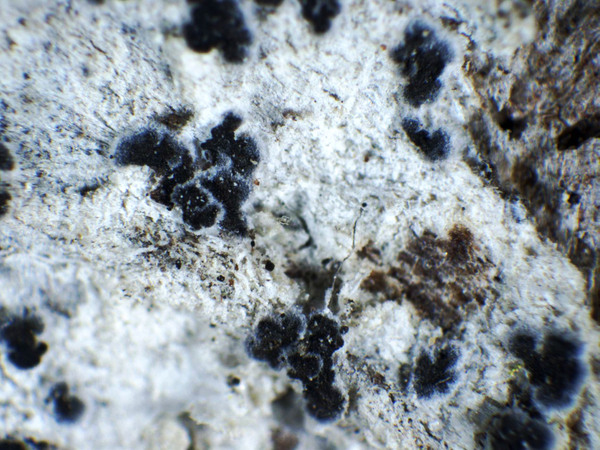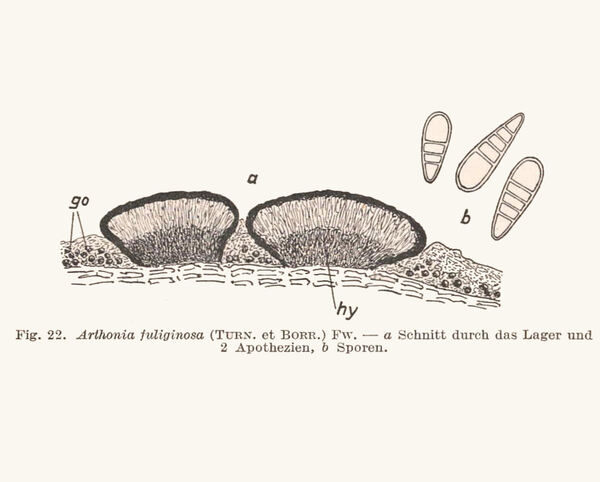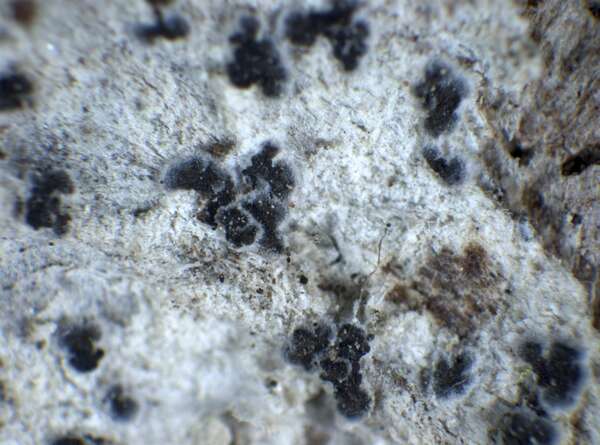Arthonia fuliginosa (Turner & Borrer) Flot.
Bot. Z., 8: 569, 1850. Basionym: Spiloma fuliginosum Turner & Borrer in Schaer. - Naturw. Anz. allg. Schweiz. Ges. Naturw., 5: 33, 1821.
Synonyms:
Distribution: N - Frl, TAA (Nascimbene & al. 2007b).
Description: Thallus crustose, thin, usually continuous, grey-white to pale yellowish, Apothecia arthonioid, at first rounded, then ellipsoid, flat to slightly convex, to 1 mm across, angular or lobed, brown-black but usually white-pruinose at least in the marginal zone, often aggregated into star-shaped clusters. Proper exciple poorly developed; epithecium brownish; hymenium colourless, 50-70(-100) µm high; hypothecium colourless. Asci 8-spored, broadly clavate, semi-fissitunicate, with a large apical dome and a distinct ocular chamber, Arthonia-type. Ascospores 3-4-septate, hyaline, sole-shaped (with unequal cells), (12-)15-22 x 6-8(-9) µm. Photobiont trentepohlioid. Spot tests: thallus K- or K+ pale lemon yellow, C-, KC-, P-. Chemistry: unknown.Note: a mild-temperate species of acid bark, especially of Abies, in humid montane forests. It is included in the Italian red list of epiphytic lichens as “Endangered” (Nascimbene & al. 2013c).
Growth form: Crustose
Substrata: bark
Photobiont: Trentepohlia
Reproductive strategy: mainly sexual
Most common in areas with a humid-warm climate (e.g. most of Tyrrenian Italy)
Commonnes-rarity: (info)
Alpine belt: absent
Subalpine belt: absent
Oromediterranean belt: absent
Montane belt: extremely rare
Submediterranean belt: absent
Padanian area: absent
Humid submediterranean belt: absent
Humid mediterranean belt: absent
Dry mediterranean belt: absent

Predictive model
Herbarium samples
Growth form: Crustose
Substrata: bark
Photobiont: Trentepohlia
Reproductive strategy: mainly sexual
Most common in areas with a humid-warm climate (e.g. most of Tyrrenian Italy)
Commonnes-rarity: (info)
Alpine belt: absent
Subalpine belt: absent
Oromediterranean belt: absent
Montane belt: extremely rare
Submediterranean belt: absent
Padanian area: absent
Humid submediterranean belt: absent
Humid mediterranean belt: absent
Dry mediterranean belt: absent

Predictive model
| Herbarium samples |
 INDEX FUNGORUM
INDEX FUNGORUM
 GBIF
GBIF
 DOLICHENS
DOLICHENS





